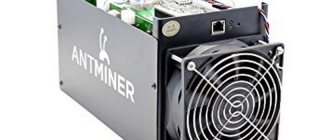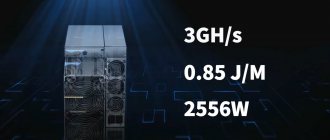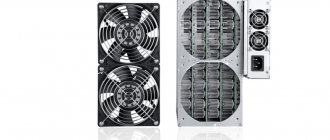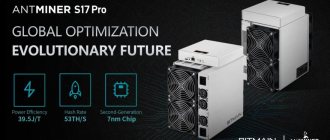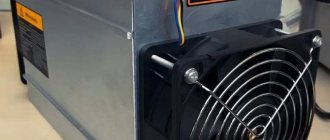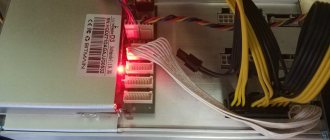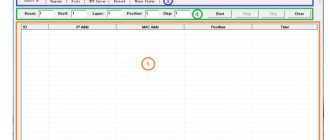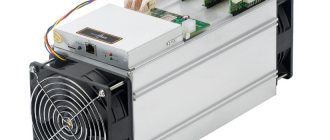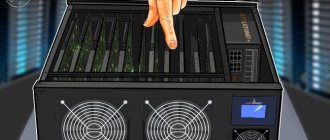- acquaintance
- new
- inclusion
- interface
- energy efficiency
- peculiarity
- prospects
- conclusion
When the usual course of events suddenly changes, and there are no official explanations for these changes, then, as a rule, rumors and assumptions begin to appear, sometimes, by the way, very far from the truth. And it doesn’t matter whether it concerns some global events or price changes in the nearest supermarket, people often begin to express their thoughts on this matter, turning en masse into analysts and forecasters.
Something similar began to happen in the spring of 2015, when, for unknown reasons, interruptions in the supply of the fifth model of AntMiner miners became more frequent. Immediately, community members began to actively comment on this event, expressing their assumptions. The dominant rumor was that BITMAIN (manufacturer of AntMiner) was developing a new chip, and since the company itself did not react in any way to such an assumption, the network began to issue forecasts with enviable regularity - will it happen or not, and if it happens, when exactly?
Some confidence that it would “happen” appeared at the beginning of the summer, but since the release dates of the new product were constantly postponed, the situation became more and more vague and became surrounded by more and more new rumors. It was resolved in September 2015 with the release of the new AntMiner S7 to the market, which will be discussed in this article.
First acquaintance with AntMiner S7
The first acquaintance with the new miner from BITTMAIN can be compared to the first date with a person whom you previously knew only on the Internet. In the sense that you don’t know what to expect in reality, and how similar the virtual and real impressions will be.
It all started well. The delivery time was less than a week (it’s not a fact that all users will be as lucky, but there is at least hope), and this, taking into account all the customs “troubles,” is almost ideal. The goods were accompanied by an invoice drawn up in accordance with all the rules, placed in a special outer bag for documents of this kind.
The box with the order weighed only 4 kilograms, which gave rise to some doubts that there really was an ASIC with a power of almost 5 TH/s (or rather, 4.86 TH/s, to be precise). The memories of a year ago samples that, with more than 2 times less power, weighed 6 times more, made me doubt it. However, opening the parcel dispelled all fears; it turned out to be the long-awaited device for mining crypts, which was even (incredibly!) accompanied by valuable recommendations for its use. We assure you that the document is very useful and necessary, so we advise you not to lose it even after careful study, because you can never exclude the possibility of missing or forgetting some details.
After unpacking the AntMiner S7 miner, do not hesitate to shake it thoroughly, while listening carefully for any extraneous sounds indicating that something is loose inside. Believe me, this is far from idle advice - sometimes unpleasant surprises occur in the products of this manufacturer in the form of small parts falling off (for example, radiators), so if the slightest suspicion arises, it is better to open the ASIC and check everything. Although, it is quite possible that the rattling creates a slight play in the boards located in special slides, and not secured with bolts, as before.
If the reason is this very backlash, then do not rush to be indignant. On the contrary, be glad that you received a device in a new aluminum (not tin or plastic) case, multifunctional and of high quality, unlike previous models. This is a real step forward for the developer. Thanks to a simple but effective housing design solution with recesses and skids, it is now possible to connect several devices into one unit.
The long-awaited appearance of a miner
In the spring of 2015, Bitmain, wittingly or unwittingly, provoked a stir around the release of its new product to the market to replace the Antminer s5 that was then being sold with a good return on investment. A technological breakthrough and a sharp increase in profitability were expected from the new product, but due to the lack of official information until the summer, the rumors remained rumors. By mid-2015, Bitmain officially confirmed the release of the then new BM1385 chip, which almost guaranteed a quick update to the ASIC lineup.
This update occurred in the fall of the same year with the release of the first batch of S7. The miner turned out to be much lighter than its predecessors - weighing 4 kg - despite the multifunctional metal body. And it actually had BM1385 chips installed, the implementation of which promised a hashrate of about 4.86 TH/s.
After the release of the new ASIC miner, representatives of the thematic resource bitcoinist.com interviewed Jihan Wu, the founder of Bitmain, and then received a sample mining device with the following characteristics for testing:
- Hashrate: 4.86 TH/s (+5%)
- Energy consumption: 1210 watts (this parameter and energy efficiency indicator are indicated when using APW3, at a temperature of 25C in standard “cruising” operating mode - without overclocking).
- Energy efficiency: 0.25 J/GH.
- Voltage: recommended 12V+5%, but not less than 12.0V.
- Number of BM1385 chips per device: 162 pcs./3 boards (option: 135 pcs. on 3 boards was described later).
- Dimensions: 301mm (L) * 123mm (D) * 155mm (W).
- Cooling: 2 (or 1) coolers.
- Operating temperature: 0-40C
- Network connection: Ethernet.
The filling of the device is inserted into an aluminum case, on the outer side of which the control board and coolers are located. The front part contains an Ethernet network socket, a slot for an SD card, two LED indicators, reset buttons and “IP Search” buttons.
Three parallel-connected boards are built inside the S7 case, each of which has a solid radiator installed on one side, and a set of individual chip radiators on the other.
At the top end of the board there is a standard 6-pin PCI-e power interface and a cable intended for connection to the control board.
In the work of S7, when comparing it with S5, they noted a revolutionary ratio of power and energy consumption for 2015. So, if S5 gave only 1.155 TH/S with a consumption of 600 watts, S7 with a doubling of power gave a hashrate already 4 times greater. The device specifications, depending on the modification of this ASIC, contained slightly different hashrate parameters. For later serial versions of S7, hashrate values of about 4.73 TH/s ±5% are given, which are provided by 135 chips (45 pieces per board).
The BM1385 chip operates on 28nm processors. By using a larger contact area and heat dissipation, this allowed for a technological leap and provided the potential for further optimization of the device.
Appearance and “filling” of AntMiner S7
The S7 is designed without any special tricks, but not at the expense of functionality. The case is compact, lightweight, made of aluminum and equipped with special devices (runners) that allow you to connect as many devices as you like into a single chain. On the case (on its outer side) there is a network adapter and a cooling device (cooler). The front panel is equipped with an Ethernet connector and 2 LEDs.
Now let's get acquainted with the internal structure of the miner. There are 3 boards located here, each of which has heat sinks. They are located on different sides of the boards - on one side there is a solid board, and on the other there are individual processor boards. On top of the boards there are standard PCI-E power connectors. The hashing speed, about 5 TH/s, is provided by 135 computing processors.
This ASIC was the first to use VM1385 model chips, which replaced the previously used VM1384 chips. The new chips are twice as powerful and much more energy efficient. The power supply is not included in the kit, but for those who already have this device, this is more of a plus than a minus, as it eliminates unnecessary expenses.
Advantages and disadvantages
pros
- Given the high complexity of the network, only ASICs can provide decent income.
- Compared to video card farms, ASIC consumes less power.
- An ASIC miner takes up less space than a GPU farm.
- The device is easier to install and configure by simply following the instructions.
Minuses
- High price.
- Reselling an outdated or unnecessary device is almost impossible.
- One device allows you to mine coins of only one algorithm.
- The large number of ASICs used and mining on them on an industrial scale are detrimental to the decentralization of the network.
- "Obsolescence".
Turning on for the first time
The first switch-on is a very important matter and you need to carefully prepare for it. And this is no exaggeration.
Judge for yourself. To power all AntMiner S7 connectors, you must have a power supply with 10 PCI-E connectors (3 for each board and 1 for the control board). Finding a reliable power supply is not as easy as it seems. It happens that devices with very good characteristics simply fail to cope with the test, as happened with us with one of these vaunted units (Enermax Planimax 1500), while the simpler PSU EVGA 1300 G2 did an excellent job.
Payback of the device
The increasing complexity of mining in the Bitcoin network has made the payback period for S7 when mining this cryptocurrency not just very long. She put the use of S7 in bitcoin mining below the level of profitability already at a price for electricity of 5.38 rubles per 1 kWh and 2.5% of the pool fee as part of AntPool. That is, according to the calculators, the monthly loss when mining bitcoins using the S7 will be about $18, and the loss when mining with the Antminer S7-LN modification will be about $6 per month.
The average cost of an S7 on the market at the end of 2017 and beginning of 2018 was about $1,000. Sometimes used devices with high mileage can be found for $350, but this is rather the exception to the rule. Therefore, it will most likely not be possible to “recapture” the device by mining bitcoins. But you can try profitable mining on other cryptocurrencies with the SHA-256 algorithm:
- Bitcoin Cash.
- Steem Dollars.
- Steem.
- Syscoin.
- Counterparty.
- Namecoin, etc.
Of the altcoins presented on the market at the beginning of 2022, Steem is considered the most competitive, with a capitalization of about $770 million and a market value of about $3/Steem, as well as its fork. Namecoin (about $24.11/XCP), Unobtanium (about $115/UNO), Paccoin and other cryptocurrencies are of current interest.
Briefly about the AntMiner S7 interface
In short, because in appearance and menu everything is mostly familiar to you. And if there are some innovations, they are also quite simple and understandable, which allows us to characterize the interface in general as “user-friendly”.
ASICs from BITMAIN are generally distinguished by the convenience and wide functionality of their web interfaces, and AntMiner S7 is no exception. The settings here are divided into sections, and the sections are divided into separate tabs, which makes work easier and faster. Wide functionality is also not our invention. You will have the opportunity to configure, monitor and optimize the work of your “miner”, and will also be able to get complete statistics on how its capacity is used.
But it still makes sense to dwell on one of the new functions in more detail. We will talk about the ability to control the cooler operating frequency settings. This is a truly necessary and important innovation that is worth experimenting with. Thanks to this feature, you can solve the noise problem without boosters and the hassle of replacing coolers. The “native” coolers of the AntMiner S7 ASIC are distinguished by high power, but they are also unimaginably noisy. Now it is possible to set a certain percentage of the planned power and work calmly, without suffering from constant stress on the eardrums. For example, if you use the coolers at only 40%, then the revolutions will drop to 3120 per minute, and the temperature will increase by only 10 degrees (about 57 degrees for each board). This function is especially relevant for mining devices that are located in residential premises.
And I would also like to note the overclocking capabilities that are provided here in the range from 100 megahertz to a thousand (with a planned frequency of 600 megahertz).
Content
- Appearance of ASIC Antminer S7
- Technical characteristics of ASIC Antminer S7
- Connecting and setting up ASIC miner Antminer S7 What other factors should be taken into account when setting up ASIC S7
In September 2015, the Chinese company Bitmain released a new miner called Antminer S7, which was the predecessor of the popular Antminer S9 model today.
The main distinguishing feature of ASIC S7, which sets it apart from previous models, is the use of the BM 1385 chip. The Antminer S7 device is designed for mining using the SHA-256 algorithm. Thanks to this, the user can mine the following types of cryptocurrencies:
- Bitcoin;
- Namecoin;
- BetaCoin;
- Peercoin;
- Unobtanium and others.
Energy efficiency AntMiner S7
Another important and, in this case, pleasing characteristic of ASICs is their energy consumption. In the seventh model it not only pleases, but even stuns. You can see this for yourself if you compare the performance of the previous S5 model and the seventh model we are considering.
In the first case (S5), the device consumes 600 watts with a performance of 1.15 TH/s. In the case of AntMiner S7, power consumption has increased slightly more than twice (1250 watts), but performance reaches almost 5 TH/s. So, in terms of energy efficiency, this ASIC is clearly superior to earlier models.
Cryptocurrency mining using ASIC Antminer S7
Interface of the F2Pool platform for ASIC mining Antminer S7
Based on the fact that the ASIC S7 miner uses the SHA-256 algorithm to mine cryptocurrencies, it can mine various cryptocurrencies, including Bitcoin. Since solo mining as the network becomes more complex is increasingly unprofitable, it is better to connect the ASIC to the pool. The most popular and reliable services are:
- F2Pool
is a Chinese pool that allows you to mine Bitcoin, Litecoin, Dash and other cryptocurrencies. - BW.com
is a service from the Chinese ASIC manufacturer BW. - BTC China
is a pool from the Chinese crypto exchange of the same name. - AntPool
is the official pool of Bitmain.
Some features you need to know
I would like to draw your attention to a number of features that it is advisable to know about when working on the S7:
- First, keep in mind that your device will use more or less power depending on how efficient the power supply is, how high the operating temperature is, and how accurately the power meter is working.
- The second point is that purchasing a power supply will fall on your shoulders, since it is not included in the miner kit. There is no need to save money here; buy a high-quality power supply, because the “law” of the miser who pays twice may come into play. If you buy a cheap Chinese device with small gauge wires, sooner or later (more likely sooner) they will melt.
- Finally, if you are connecting the hash boards and the control board to different units, you must connect the hash boards first and then the control board.
What types of ASICs are there?
what kind of ASIC miners are there?
There are three main types of ASIC miners :
- Professional. High-power devices that consume more than a kilowatt of energy per hour are equipped with integrated power supplies and the best cooling systems. Show better energy efficiency and performance. An example is Antminer S9, one of the most popular ASICs in the world.
- For home mining. They have average characteristics in terms of power and energy consumption. Examples - Innosilicon A4+ LTCMaster, Antminer L3++, Baikal-X. Consumption is in the range of 600-800 W. The quality of the case materials and internal components is slightly lower than that of professional models.
- Compact. Connects to USB and consumes little power. Of course, their power leaves much to be desired, but they are often chosen for their convenience - all you need to do is connect the device to a PC. Examples of such models: Bitmain Antrouter R1-LTC, Gekko Science 2PAC BM1384, etc.
ASIC miner Bitmain Antrouter R1-LTC
Future prospects
It’s no secret that every year the complexity of generating cue ball blocks becomes more complicated, and as a result, the profitability of the mining process decreases. For these reasons, the payback period for ASICs is increasing, including the S7 miner. But there is another aspect here. The payback period may also decrease if the BTC rate systematically increases, as has been happening recently.
Approximate results of ASIC profitability can be calculated using a calculator. To do this, you need to enter data on the average cost of electricity, take into account the pool payment and the size of the block reward.
We will not provide calculations; we will only note the fact that their results indicate that an acquisition such as AntMiner S7 will be unprofitable in the next year, 2022.
With all its advantages, such as fairly high performance, low power consumption, relatively low price and no problems with replacing failed parts, this device is still much inferior in many respects to the new generation models. Therefore, if you do not want to lose your investments and end up in the red, it is better to pay attention to them. This will, of course, be more expensive, but much more effective.
Common problems at work
When describing work on forums, from time to time a message appears about a similar problem in the operation of S7, which describes the situation of a sharp decrease in the speed of the device. The period from the start of work to the deceleration is indicated differently in different cases, but, as a rule, this happens within the first hour. To eliminate the problem, various techniques are proposed based on the following main hypotheses.
- Overheat. The assumption that chips and boards are overheating is most often not confirmed, since coolers continue to spin at 90-95% power and the temperature on boards and chips remains within normal limits.
- Problems with the router and Antminer settings. When solving the problem using this path, the settings are reset to factory settings. To do this, insert a knitting needle or toothpick into the hole to the right of the indicators (see illustration) and hold it for 10 seconds until a beep sound appears. This sometimes helps get rid of the problem, but not always. Often, resetting the settings leads to the S7 appearing on the network again (before this, the router, as a rule, does not see the ASIC), but the speed still does not increase. New firmware makes it possible to slightly increase the operating time at normal speed, but soon it drops again, and the device beeps, signaling a malfunction.
- Replacing controllers. The described problem is caused by the failure of the controllers. Replacing them radically solves the problem, but increases the cost of Antminer by about $35-40.
In any case, the practical part of the recommendations usually begins with the advice to switch from Nice to Ant and check the functionality of the device there. Despite some typical problems, in general, this Antminer model is quite reliable.
